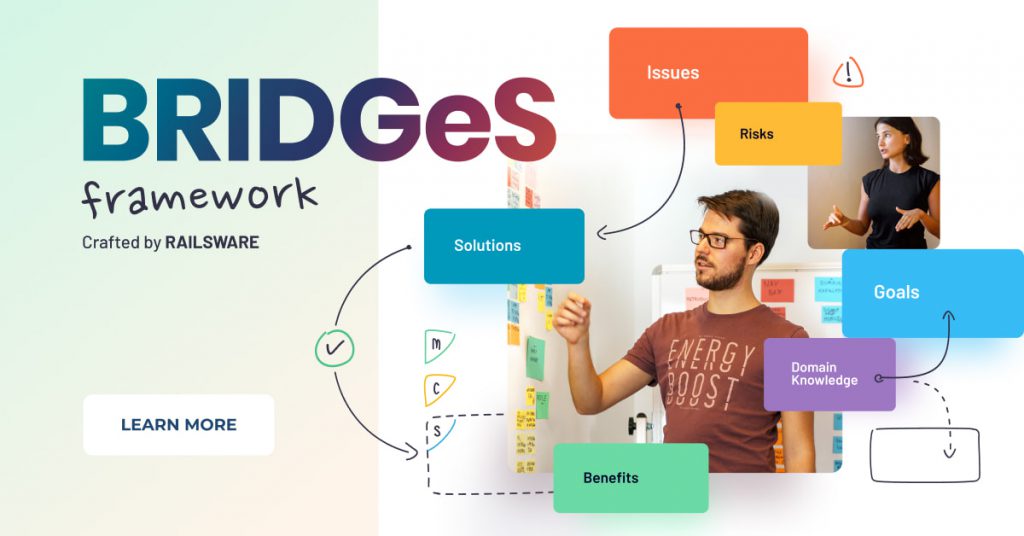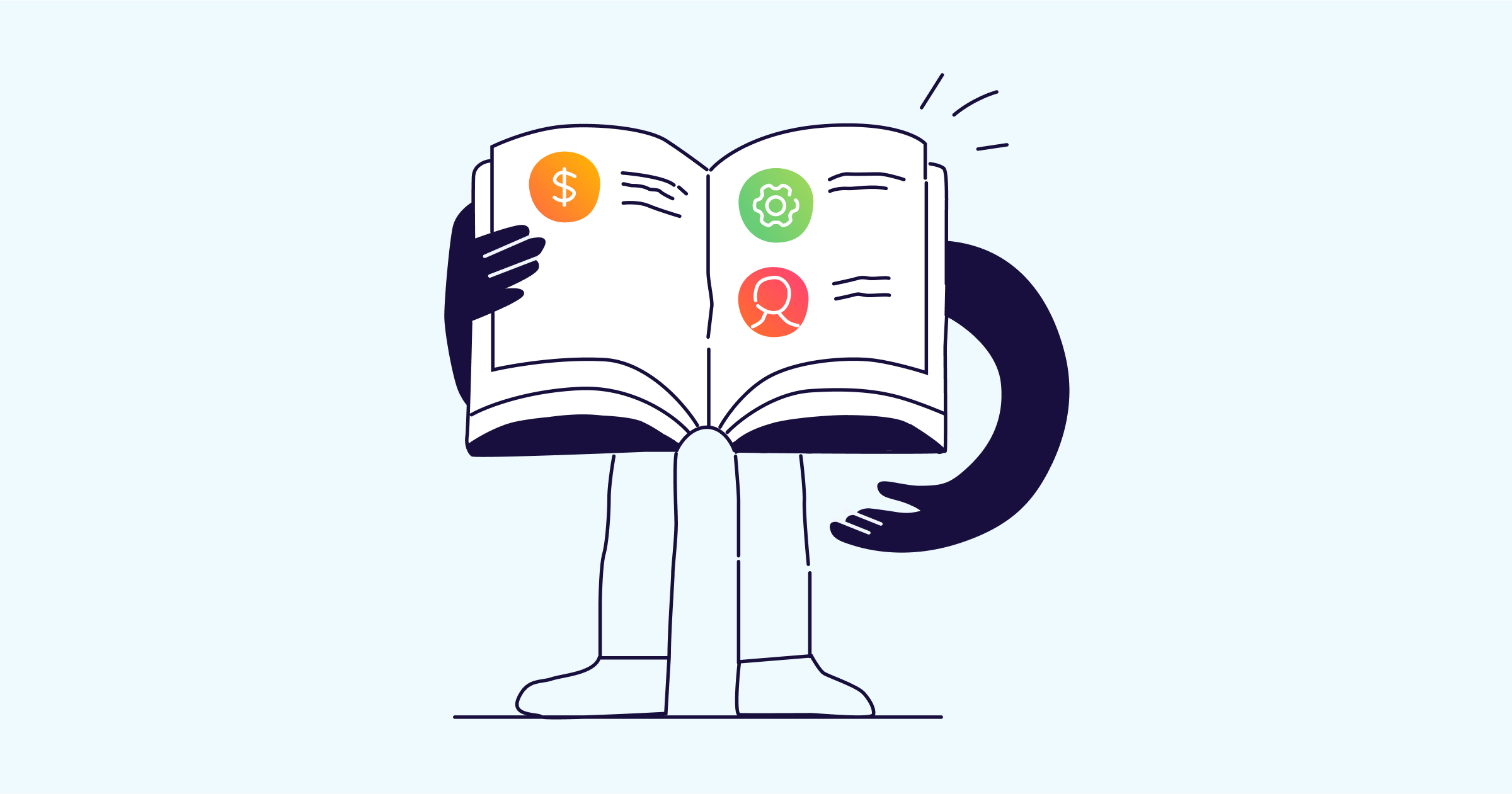
What is Product Value?
Product value can be summed up as the benefits customers get from using your product. It describes the extent to which your product solves a real problem and satisfies customer needs.
Crucially, product value is a subjective concept, and customer perception lies at the heart of it.
That’s why we can’t equate value with something as simple as the price, feature set, or popularity of the product. It’s shaped by several factors, including customers’ preferences, past experiences, routines, and spending habits.
How to Define Product Value
As we said, product value is subjective. But it’s still possible to define value from the perspective of time and money – something everybody wants more of.
Every B2B software product should either save your customers money, earn them money, or save them time. To create product value, SaaS product managers must ask critical questions like:
- How much time do customers save by using our product?
- How much do customers have to gain by using our product?
- How crucial is the product to our customer’s income?
- Can they avoid using our product?
For example, the team at Coupler.io estimated that if each customer had spent even 2 minutes on a manual export and loading data to build a dashboard before using the tool, then Coupler has already saved 100 years of people’s time.
What’s the difference between product value and price?
It’s common to see the concepts of price and value used interchangeably. But Warren Buffet’s famous quote neatly sums up the difference: ‘Price is what you pay, value is what you get.’
One way to visualize this difference is with the Value-Price-Cost framework.
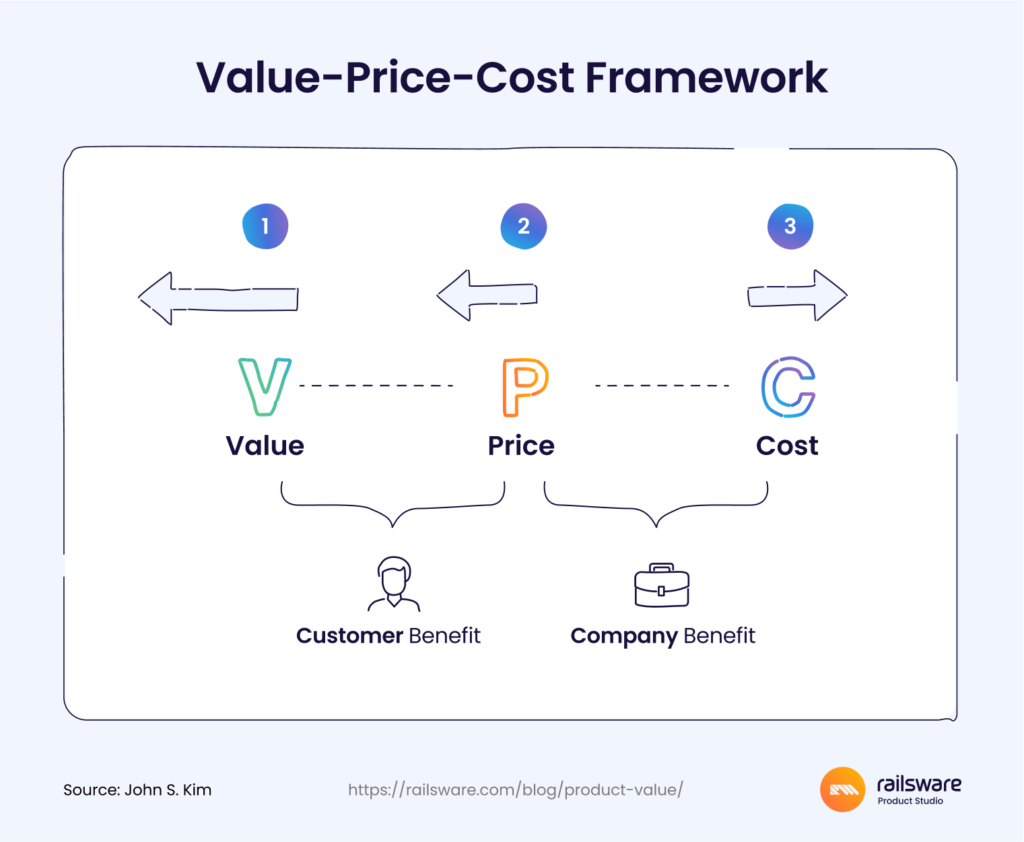
Value: the worth assigned to a product based on its benefits and utility.
Price: what you charge people to use your product.
Cost: the costs involved in creating, maintaining, and improving the product.
The bigger the gap between Value and Price, the higher customer satisfaction. Basically, the more bang a customer gets for their buck, the happier they are.
If a customer is paying $100 a month and extracting lots of benefits from the product – possibly more than they first expected – then they will perceive your product as being high-value. If they are paying $500 a month and only getting minimal benefits from the product, then the overall value of your product will be low. But if they were paying $500 and getting a great customer experience, then the value may be high. Value is dependent on the benefits you offer, not on the price point.
That said, price can contribute to product value. In certain cases, it can increase a product’s desirability (e.g. prestige pricing) or decrease it (when a low price point suggests a low-quality product). To read more about the factors that influence purchasing decisions, see our guide to B2B SaaS pricing.
Types of product value
- Absolute value is the product’s intrinsic value, typically the sum of a product’s features and functionality. For example, the absolute value of GitHub is defined by its robust version control system, wide range of integrations, and how it allows users to easily collaborate on large-scale projects and write/maintain documentation.
- Monetary value is the financial benefits that a customer gains by choosing a product, e.g. cost savings, ROI, etc. For example, Shopify allows small businesses to earn money by selling their product online. Likewise, Stripe enables businesses to accept online payments and grow their customer base/profits, thus providing monetary value.
- Relative value is the value of the product in direct comparison to market alternatives. What sets your product apart from your competitors? Consumers will usually consider factors like quality, brand reputation, functionality, and pricing.
- Perceived value is how much a consumer thinks a product is worth based on its benefits, virality, brand reputation, emotional appeal, and price. For example, a well-known app with a track record for excellent support likely has a higher perceived value than a similar, lesser-known app.
- Social value is the product’s ability to connect users with other people (e.g. colleagues, clients, wider community). Slack and Zoom are a couple of obvious examples. But we can also say that apps like Typeform, Zendesk, and Mailchimp provide social value because they help users build customer relationships.
Can You Measure Product Value?
The short answer is yes, but the process of measuring product value should be 50% data-driven, and 50% listen-to-the-people driven. What do we mean by that?
Data gives us an insight into how customers feel about our product, based on factors like active usage and subscription renewals. But it doesn’t tell us the extent to which customers are satisfied with our solution. For that, we need to get closer to the source.
For a start, let’s look at how customer development (CustDev) efforts help us measure product value.
Listen to the people
Customer development is an agile methodology developed by Steve Blank. It consists of four steps, but at Railsware, we often focus on the customer interview component. From experience, interviews are one of the best ways to build relationships with customers and learn what it takes to delight them.
When measuring value with CustDev, you need to be able to test your assumptions against interviewees’ answers. For that, our software agency recommends creating product hypotheses in advance. A basic example might be: ‘Customers use our product because it saves them time on project planning.’ Or ‘Our automation features help customers cut down on their marketing costs.’
For best results, make interviews less of an interrogation, and more of a conversation. Engage in small talk and give the customer space to tell their own story. It’s also essential to ask the right questions. Go deeper than ‘What do you like about our product?’ or ‘What should we improve?’ Here are some sample questions to ask interviewees.
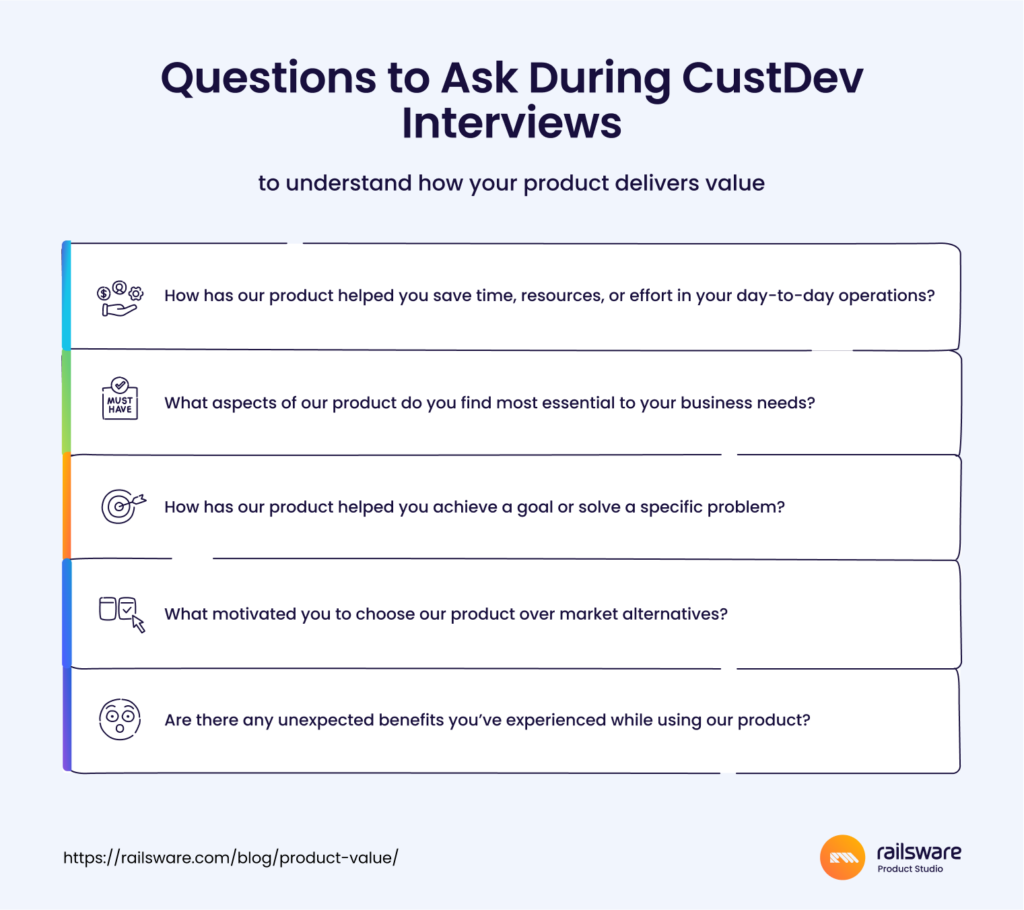
What about surveys?
Conducting a survey is a low-effort, cost-effective way of gathering quantitative data on customer needs and preferences. But this convenience comes with its drawbacks.
On the whole, customers don’t like participating in them. They are wary of the company’s motives and unsure if their opinions will be listened to. Not to mention, survey results aren’t super reliable. Customers often unintentionally lie or provide contradictory information in surveys, and thanks to multiple-choice questions, answers lack detail and nuance.
But surveys are still a useful tool for gathering customer feedback. Launch them when you need to validate product-value hypotheses quickly. Using the QR code generator to place scannable codes on products, receipts, or displays can streamline this process by directing customers to your feedback forms when scanned through a phone’s camera or a specialized web-based QR reader. For instance, at our software agency, we often use surveys to validate whether a hypothesis (e.g. new feature) is true for most of our users, or only a small percentage of them. To get answers to our broader, more abstract questions, we use CustDev.
Pay attention to key metrics
As we said, it’s more difficult to extract actionable information from quantitative data than from our CustDev efforts. In one scenario, we’re trying to interpret how customers feel based on statistics. On the other, we get to ask them directly.
The downside to CustDev is that customers don’t always know what they really think or feel about a product, nor can they pinpoint its precise ROI or benefits.
But data analysis helps us fill in the gaps. Product dashboards allow us to understand user habits, spot trends in customer behavior, and assess the ‘absolute value’ of our product based on factors like feature usage and revenue growth.
Here are a few of the most important metrics to track when measuring product value:
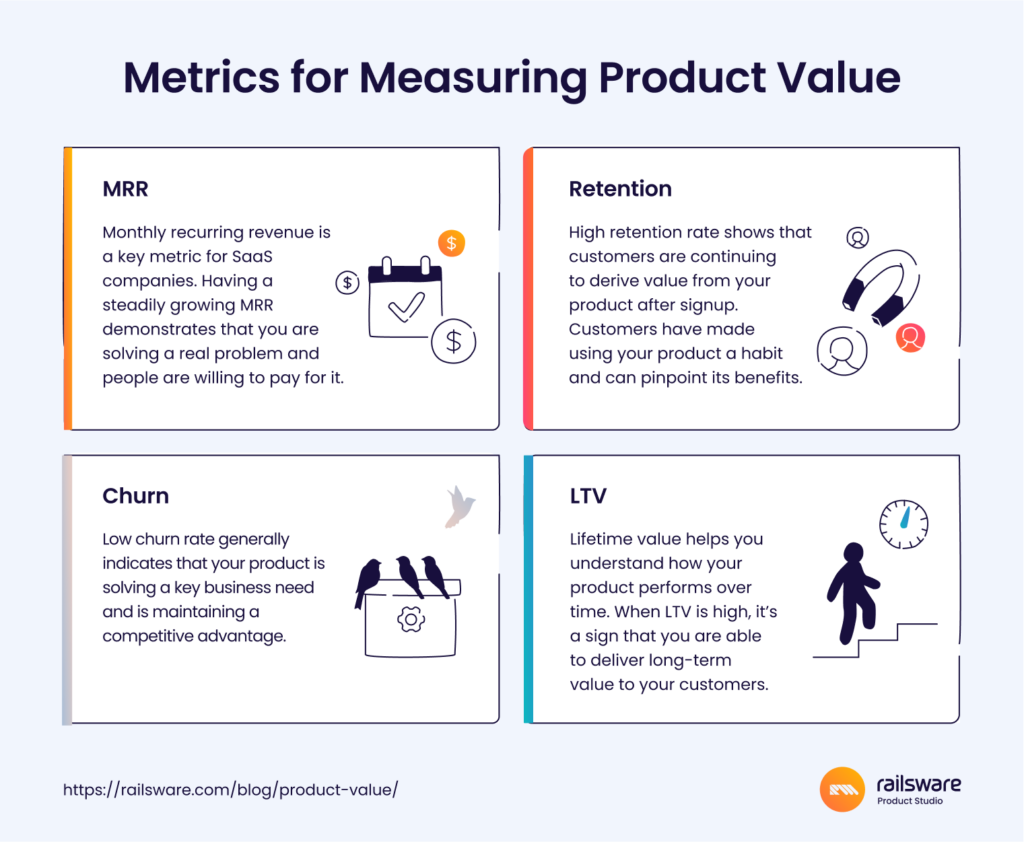
How to Add More Value For Your Customers
Increasing the value of your product is also a two-pronged approach. It’s about striking a balance between following the data and chasing a dream. So, what kind of strategies should you use to achieve that balance? (and ultimately, a product-market fit)
Design for habitual use
If you can make using your application a habit for customers, you’ve already won half the battle. There are a couple of reasons for this:
- It saves customers time. The longer we use a product, the more comfortable we become with using it. In a B2B SaaS context, this makes our jobs easier and saves us time. Once we become proficient at say, creating an analytics dashboard in GSheets, or sending messages in Slack, we’re more reluctant to switch to another tool – regardless of its promised benefits.
- Habitual use of a product fosters customer loyalty. When something becomes part of our daily routine or work life, we are more likely to place a higher social and perceived value on it.
The Fogg Behavior Model, developed by behavior scientist BJ Fogg, provides insight into why customers behave this way. It suggests that three elements must converge at the same moment for a behavior to occur: motivation, ability, and prompts.
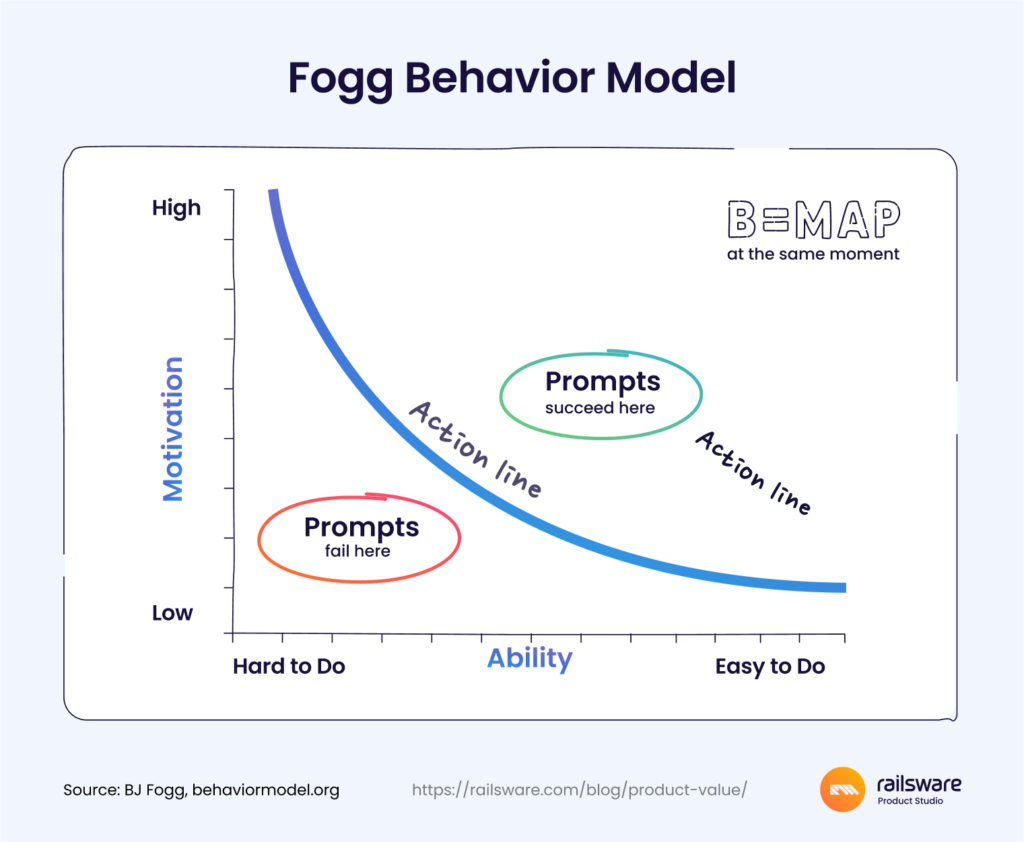
Here’s a definition:
- Motivation: Person’s desire or willingness to perform a behavior is influenced by needs, goals, emotions, and personal values.
- Ability: Person’s capacity to perform the behavior is based on skills, knowledge, and resources available to them.
- Prompts: Triggers that initiate the behavior, divided into spark triggers (grabbing attention and creating motivation) and facilitator triggers (providing reminders or resources).
To capture all three, we need to create a product that solves a real need, offers an enjoyable user experience, contains triggers that motivate users to keep coming back, and last but not least, we need to create a logo that is noticeable and eye-catching.
Take the language-learning platform Duolingo as an example. Duolingo allows customers to learn a new language on the go, saving them time and money on ‘official’ lessons. It offers a gamified user experience that includes progress tracking, leaderboards, and instant feedback – features that promote engagement. Its bite-sized lessons and wide range of languages make it accessible to a huge audience. And it employs well-timed mobile and email notifications to encourage users to return to the app.
Use Lean Canvas
Lean Canvas is a one-page business model tool that helps startups evaluate their business idea and design lean products. It was designed by Ash Maurya as a startup-friendly version of the Business Model Canvas.
Lean Canvas forces you to analyze your product idea from the perspective of a future customer. Ideally, you should fill it out before jumping into product development. But even if you’re already doing business, it can help you identify new ways to tune the solution and delight customers.
Some prompts are more helpful than others, such as:
Problem: What are your customer’s top 3 problems, and who’s already solving them?
Solution: What kind of solutions can you offer?
Unique Value Proposition: What’s special about your product? Why should people care?
Unfair Advantage: How will you differentiate your solution from the competition?
Customer Segments: Who are you selling to? What does your ideal customer look like?

We also recommend the value proposition canvas for getting a better understanding of your target audience’s pains and gains.
Run additional product discovery sessions
Rarely does the first version of the product align with your grander vision. So after launching your MVP and testing it on the market, we recommend running additional product discovery sessions to identify opportunities for improvement.
At Railsware, we use the BRIDGeS framework to structure product discovery. It helps us investigate the root cause of a problem, understand the context around it, and come up with actionable solutions.
- Benefits are the value that customers will derive from our future solutions.
- Risks are the issues that customers may experience in the future.
- Issues are the existing problems of the subject.
For example, having received and analyzed feedback from early adopters, what do we now consider to be our customers’ core pains? What can we offer that our competitors don’t? What are our product’s main challenges? What are we doing that already works? How can we enhance it?
These are questions our software agency can ask while working the Problem Space, and our answers will form the basis of our solutions. For a more detailed look at a BRIDGeS product breakdown, check out the Uber case study.
Don’t get tunnel vision
It’s often tempting to focus on small details rather than the bigger picture. Like tweaking the onboarding flow, adding a much-requested new feature, launching referral programs, or analyzing the conversion rate for clues on how to increase it. But success doesn’t necessarily come from making incremental product improvements. Often, it’s more complicated.
Maybe instead of finetuning the onboarding flow, you need to improve the standard of customer support e.g. hiring more agents, automating more actions. Instead of trying to improve the efficiency of ticket resolution, you need to build out your help center and create more knowledge-base articles. Or instead of adding a shiny new feature, you need to go back to the drawing board and redesign the overall solution.
The circumstances are different for each product of course. But the point is not to ignore bigger opportunities in favor of quick fixes or nice-to-haves. Keep an open mind and pivot if necessary.
How to show product value
PR, advertising, and SEO – these are all valid channels for marketing new products and building a brand reputation. Additionally, knowing how to rank on Google My Business can help businesses stand out in local search results and drive more foot traffic. But before you sink money into external channels, work on optimizing your website design and content. This is where you have the most control over how to present your product as a viable, high-value solution.
Landing page copy and headers
One way to do that is by making sure the landing page copy and headers are specific, straightforward, and easy to read.
First, avoid over-promises. Don’t use buzzwords and over-the-top phrases to describe your product offering e.g. ‘all-in-one platform,’ ‘industry-disrupting,’ ‘revolutionizing the way we do business,’ or ‘innovative/game-changing technology.’
Instead, take a problem your real customer is facing and describe how you fix it. Here are some examples from B2B SaaS homepages:
- Connect your tools, teams, and knowledge. Notion is a connected workspace loved by millions for helping their teams stay in sync and do their best work – Notion
- Smart, simple online accounting software. Track expenses, customise invoices, run reports and even more all from one place – Quickbooks
- The CRM platform to grow your business. The first CRM designed by salespeople, for salespeople – Pipedrive
- Test, Send, Control. Email Delivery Platform that delivers just in time. Great for businesses and individuals – Mailtrap.io
Explain why your solution is important and how it works, via the homepage or landing pages like ‘Features,’ ‘Services,’ or ‘Why *company name*?’ Describe the potential applications of your product with simple and specific language. Demonstrate how core product features work via screenshots, animations, and/or short demo clips. You’ll see the best eCommerce sites take a similar approach to landing page design. Using a screenshot editor can help highlight key elements and add annotations that improve clarity.
Most importantly, use customer data to shape both your communication and product strategy. That includes using the words of your customers to describe the product. Refer back to recorded CustDev interviews for inspiration, or check online reviews. If many people are calling your product an ‘integration tool,’ feature those words in your copies. If others are saying that your product ‘a great alternative to X’, then be sure to mention it too – and the reasons why your product is better than the competitor.
Social proof
Loss aversion is one of the main reasons why social proof is so powerful. As consumers, we feel our losses more deeply than our wins. We fear investing in the wrong tool or trusting the wrong company. And so we often look to others for guidance.
Businesses can use this to their advantage by showcasing customer opinions on their website. Social proof can take many different forms, including:
- A testimonial or short quote accompanied by a headshot.
- A social media screenshot (Twitter, Reddit, LinkedIn) of a customer review/positive comment.
- A video showcasing the opinions of clients on different aspects of your product.
- Logos or (true) numbers that suggest popularity: ‘100M+ users,’ ‘trusted by Atlassian, Salesforce, Adobe’ etc.
Display different types of social proof on your website: videos, data, quotes. Keywordtool.io do this well. Here’s a snippet from one of their landing pages, where they’ve combined a video testimonial with a high-profile client quote:
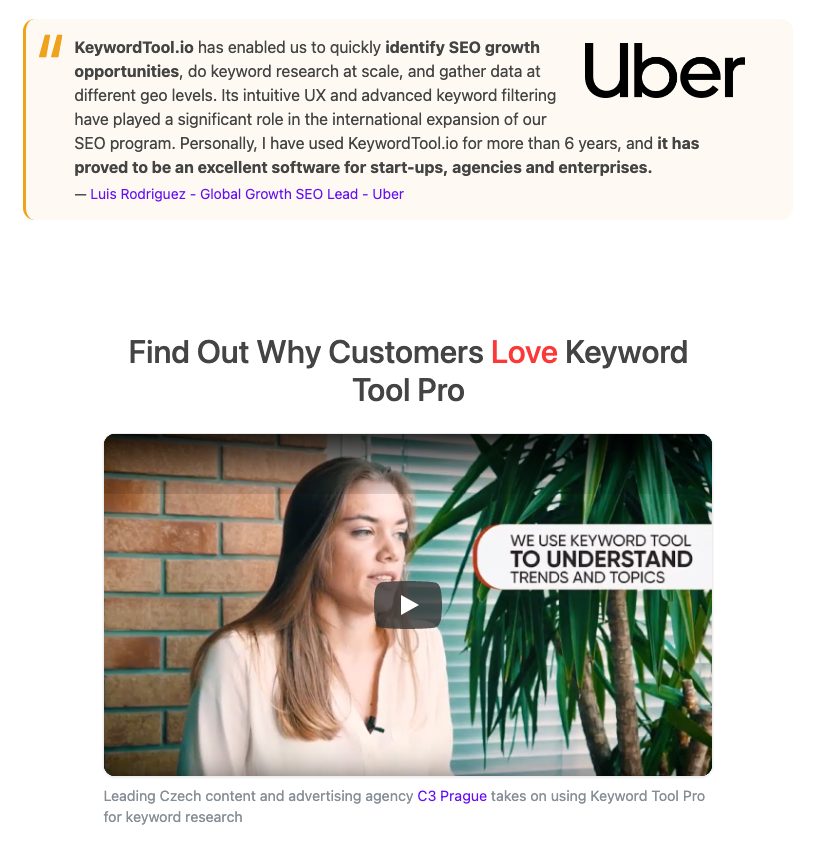
The best types of social proof show the struggle and the fix. For example, in the video above, the customer explains that they need to create content that is relevant for their clients’ audiences (struggle) and Keyword Tool helps them understand the trends and topics people are interested in (fix). They go on to mention the benefits (it’s easy to use, has great filters, provides detailed information, etc). At our software agency, we did something similar with the client video testimonial on our services page.
Also, don’t wait for customers to write about your product on Google or Twitter. Be proactive about obtaining social proof; start by asking for quotes/reviews from your early adopters. If you collect written client testimonials, you can easily create a compilation video using an AI video generator tool.
Case Studies
Case studies allow you to delve deeper into how your product helped solve a customer’s problem.
To gather the necessary information, reach out to your early adopters for an interview. Ask questions that focus on the struggle and fix: What prompted you to start using our product? How has it positively affected your workload/team/organization? What tangible results have you experienced?
Then, structure your case study into 3 parts: Challenge, solution, and results. This will make it easier for prospective buyers to understand how your product directly impacted the company.
Product value examples
Let’s look at three popular B2B SaaS applications. How do they help their customers (businesses) earn money, or save time and money?
Gong

Gong is a revenue intelligence platform that gives teams insight into how they can close deals faster, improve revenue forecasts, and create more effective business strategies.
Here’s how Gong delivers value:
- Automates the data collection and analysis process for sales activities e.g. client meetings, email exchanges, etc. (saves money)
- Helps businesses shorten their sales cycles and waste fewer resources by weeding out low-quality leads (saves time)
Gong doesn’t directly help customers earn more money (at least, not in the same way that Shopify does). But we can assume that one of the main reasons people use Gong is to improve their sales efficiency. The ultimate goal is to land a greater number of deals and, like every business, increase revenue.
Intercom
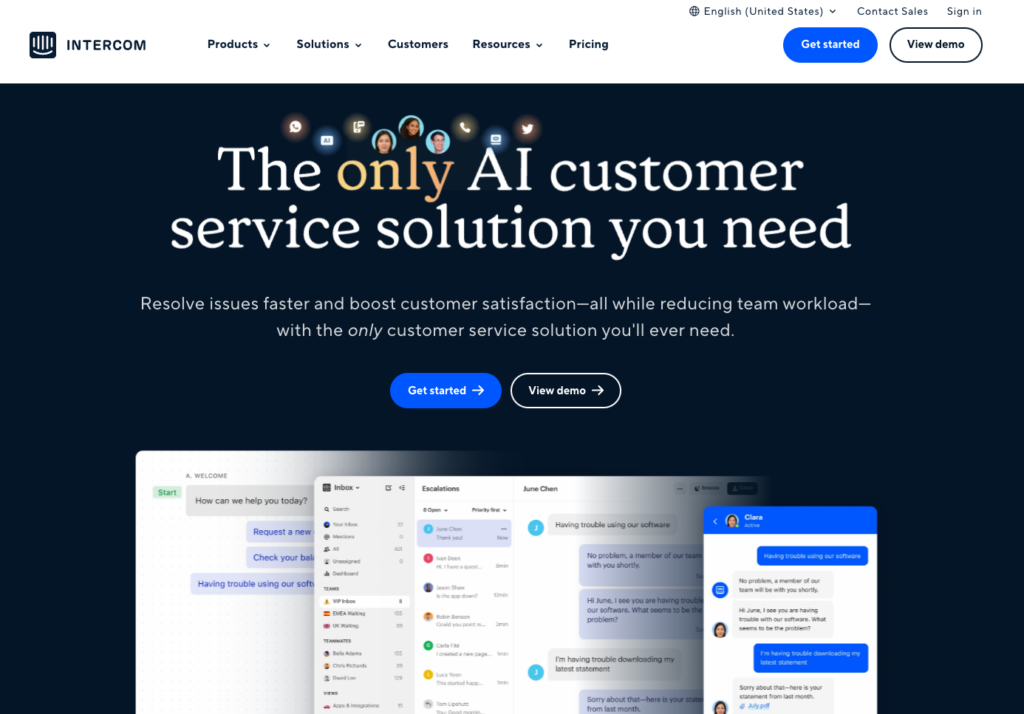
Intercom is a customer success platform that enables businesses to engage with customers through various channels, including live chat, email, and in-app messaging. It also allows them to track user behavior, provide proactive support, and onboard new users.
Here’s how Intercom delivers value:
- Allows them to automate certain aspects of their own customer service e.g. AI-powered chatbot for quick resolution of requests/complaints, reducing support costs (saves money).
- Automated personalized messaging and meeting scheduling help lighten the workload of the support and sales team (saves time).
Again, the same elements that help businesses save time and money also help them earn more money. Intercom’s automation features allow businesses to answer website visitors’ questions faster or book a call with a sales rep. The aim is to shorten the time between intent and purchase, thus helping Intercom’s customers potentially earn more money.
Miro
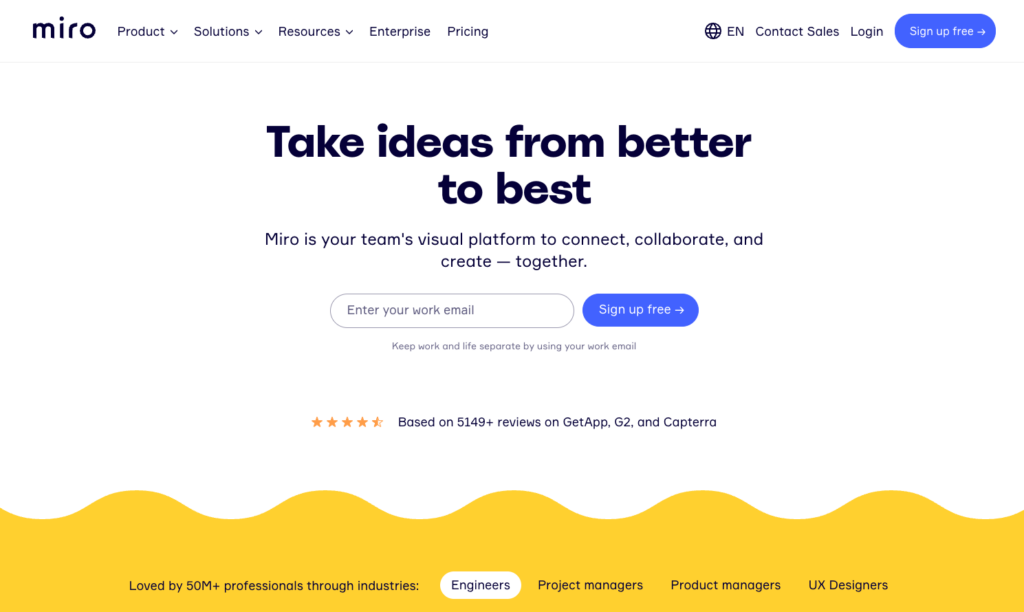
Miro is a virtual whiteboard platform that enables teams to collaborate and visualize ideas together. It provides a digital canvas where users can run brainstorms and record ideas with sticky notes, images, or framework templates.
Here’s how Miro delivers value:
- Allows teams to collaborate remotely and in real time. They can gather, exchange, and offer feedback on ideas in a central location, reducing back-and-forth communication and the need for multiple meetings (saves time)
Unlike the other two examples, Miro doesn’t explicitly save its customers money or help them earn more. But it doesn’t have to. Like we said earlier, as long as your product solves a clear problem for customers, and allows them to save either time or money – that’s value.
Final thoughts
Product value isn’t a straightforward concept, and it’s not easy to create from scratch. But it’s one of the essential ingredients of product success. We need to be constantly thinking about how we can differentiate our product from competitors and offer more benefits to our users. We must listen to customers, run discovery sessions, and adjust our vision whenever necessary. The trick is not to get caught up in the small stuff.
